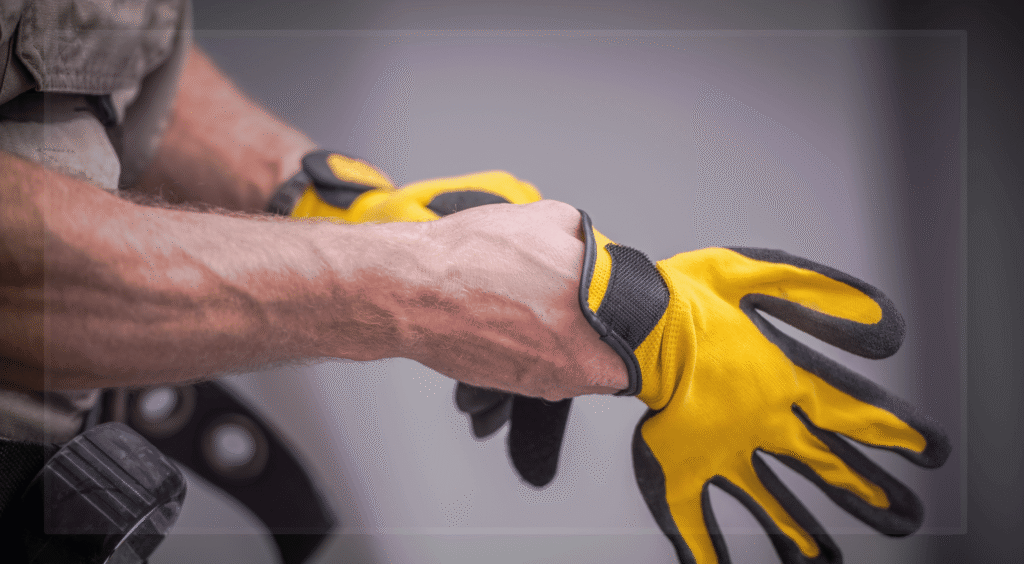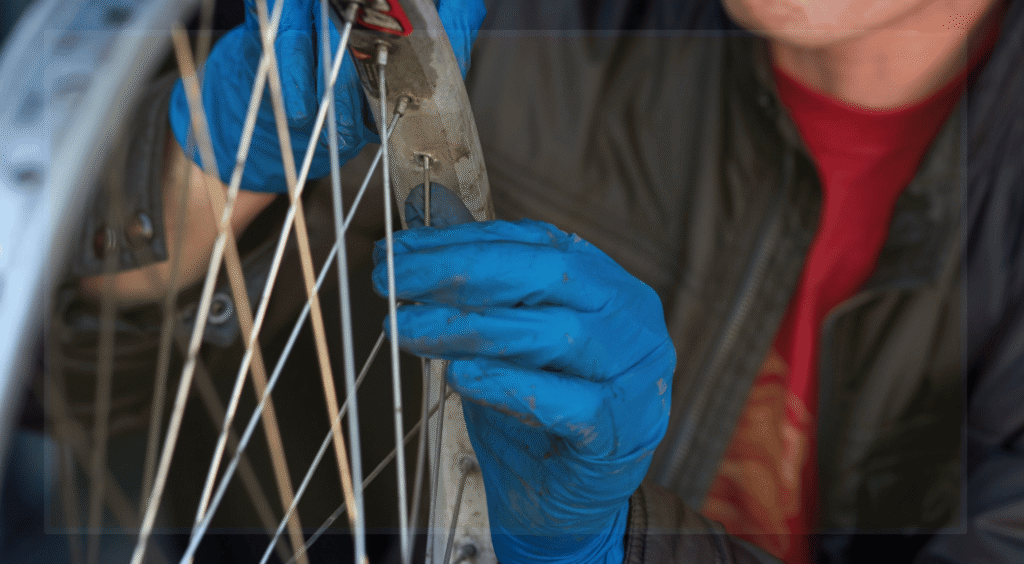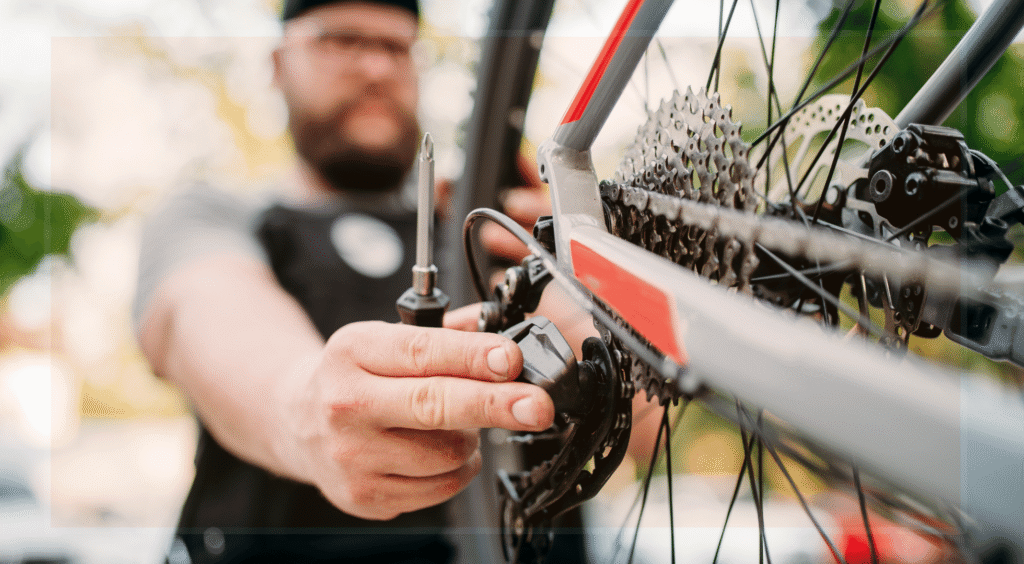When you see someone wearing gloves while working on bike shifters—whether it’s during a roadside repair or in a professional workshop—you might wonder: why do people wear gloves while working on bike shifters? At first, it seems like a matter of keeping hands clean. But in reality, gloves serve a much broader purpose. They protect against grease, dirt, and chemicals, improve grip and control, and prevent cuts and abrasions from metal edges. The right gloves—whether Cycling Gloves, Mechanix Gloves, Specialized Fingerless Gloves, HandUp Gloves, or even Nitrile Gloves—enhance safety and precision. Yet, it’s also essential to understand that gloves can sometimes pose risks if worn near moving or rotating parts. This article explores the reasoning behind wearing gloves during bike maintenance, highlighting how different glove types serve distinct purposes in ensuring safety, comfort, and efficiency.

Protecting Hands from Grease, Grime, and Abrasions
The most obvious reason people wear gloves while working on bike shifters is protection. Bike components such as chains, derailleurs, and cables are often coated in oil and debris that can irritate the skin. Regular contact with lubricants, degreasers, or sharp metal edges may cause minor cuts or even chemical burns over time.
Wearing gloves—especially durable ones like Mechanix Gloves—creates a strong barrier between your hands and contaminants. Even Nitrile Gloves are popular for this purpose because they’re disposable, resistant to oils and solvents, and ideal for precise work. They protect your skin from degreaser chemicals without compromising tactile sensitivity.
When performing quick maintenance, such as cleaning the shifter or adjusting the derailleur tension, gloves also prevent grease from embedding under fingernails or spreading to clean surfaces like handlebars or brake levers. This not only keeps your hands clean but also ensures that you maintain proper control over tools without slipping.
Enhancing Grip and Dexterity During Shifter Adjustments
Grip is one of the most overlooked aspects of safe bike repair. Proper control over tools and parts prevents accidental slips that could damage delicate shifter components or injure your hand.
High-quality Cycling Gloves or Specialized Fingerless Gloves provide excellent palm traction and allow better handling of small bolts and cables. Similarly, HandUp Gloves—known for their strong grip and lightweight design—help when fine-tuning adjustments like indexing gears or replacing cables.
The inner surfaces of these gloves are textured or padded, improving friction even when hands are sweaty or coated in oil. Compared to bare skin, gloves reduce tool slippage and finger fatigue. That’s why even casual cyclists often ask, “Do you wear cycling gloves for repair work too?”—and the answer is yes, especially when grip precision is key.
When doing detailed adjustments on bike shifters, thin gloves or fingerless models are best. They give enough tactile feel to manage screws and levers while still shielding against grime. Nitrile Gloves are also helpful when delicate touch is required, such as re-lubricating a shifter mechanism or inspecting internal ratchets.
Balancing Safety and Awareness Around Rotating Parts
While gloves protect against dirt and cuts, they can become dangerous when used around rotating parts. This is one of the most important aspects of understanding why people wear gloves while working on bike shifters—and also when not to.
When you’re working near moving components like chains, cranksets, or freewheels, gloves can catch in the rotating mechanism. A loose glove finger might be pulled in, causing serious injury. According to OSHA (Occupational Safety and Health Administration), gloves should not be worn around exposed rotating machinery because they can create an entanglement hazard.
This principle applies even in small workshop settings. If you’re adjusting gear alignment while spinning the crank or wheel, it’s safer to remove gloves temporarily. Once all motion stops, put them back on before resuming manual cleaning or part replacement.
In short, gloves are a protective tool, but they must be task-appropriate. Avoid wearing loose-fitting gloves near moving parts; instead, use snug-fitting ones if necessary, or work bare-handed when mechanical motion is active.
Choosing the Right Type of Gloves for Bike Maintenance
Understanding why people wear gloves while working on bike shifters is only half the story—you must also know which type of glove to choose. Different gloves serve different purposes:

1. Cycling Gloves
Designed primarily for riding, Cycling Gloves reduce vibration, absorb sweat, and improve handlebar control. While they’re not built for mechanical work, they’re useful during quick roadside adjustments. Their padded palms provide comfort and extra grip.
2. Mechanix Gloves
These gloves are built for durability. Mechanics and bike technicians often rely on Mechanix Gloves when performing heavy-duty maintenance. They’re excellent for protecting against cuts, hot surfaces, and sharp tools, though slightly thicker—so not ideal for fine cable work.
3. Specialized Fingerless Gloves
Specialized Fingerless Gloves are great for tasks requiring high precision. The exposed fingertips maintain tactile control, allowing you to feel tiny screws or cables while still keeping your palms safe.
4. HandUp Gloves
These gloves are popular among off-road riders and repair enthusiasts. They balance protection and flexibility, ideal for adjusting derailleurs or brake levers in field conditions.
5. Nitrile Gloves
If cleanliness and chemical resistance are your priorities, Nitrile Gloves are unbeatable. They prevent direct contact with oils, degreasers, and brake fluid, and are inexpensive enough to dispose of after each session.
Selecting gloves is about finding the right match for the job. If you’re handling lubricants, choose Nitrile Gloves. For heavier wrenching, opt for Mechanix Gloves. For light adjustments, Fingerless or Cycling Gloves will do.
Are Gloves Necessary for Working on Bike Shifters?
Many riders and mechanics ask: Are cycling gloves necessary for working on bike shifters? The answer depends on the situation. Gloves aren’t mandatory, but they’re highly recommended for both safety and comfort.

When replacing cables, cleaning gears, or tightening bolts, gloves protect your hands and enhance grip. However, if the repair involves moving parts or high-speed rotation—like spinning wheels or chainrings—it’s safer to avoid gloves entirely.
Gloves should be viewed as part of personal protective equipment (PPE). Just as you wouldn’t weld without goggles, it makes sense to protect your hands when handling tools and lubricants. Following workshop safety standards, such as those outlined by Wikipedia’s “Personal Protective Equipment” entry, helps reduce long-term injury risks.
In summary, wear gloves for protection and precision—but remove or tighten them when working near rotating shafts or active drivetrains.
Comparison Table: Best Gloves for Bike Shifter Work
| Glove Type | Primary Purpose | Protection Level | Comfort & Dexterity | Best For | Notes |
| Mechanix Gloves | Heavy-duty maintenance, wrenching | ⭐ ⭐ ⭐ ⭐ | Moderate (thicker build) | Installing new shifters, cutting cables, wrenching | Long-lasting and reusable but slightly bulky for fine tasks. |
| Nitrile Gloves | Clean, chemical-resistant precision work | ⭐ ⭐ ⭐ | Excellent (thin fit) | Degreasing, oil handling, brake fluid work | Disposable, low cost, and ideal for chemical safety. |
| Cycling Gloves | Light adjustments or ride-prep | ⭐ ⭐ | Very High | Quick roadside tuning or shifting tests | Excellent grip and sweat control but not chemical resistant. |
| Specialized Fingerless Gloves | Fine tuning with tactile feel | ⭐ ⭐ ⭐ | High | Cable tensioning, small part assembly | Great for precise handling, protects palms, exposes fingertips. |
| HandUp Gloves | All-around flexibility | ⭐ ⭐ ⭐ | High | Outdoor maintenance or trail-side repairs | Durable, comfortable, and suitable for on/off-bike tasks. |
This table simplifies glove selection: choose Mechanix for strength, Nitrile for chemical resistance, Fingerless for precision, and Cycling or HandUp Gloves for flexibility.
Practical Workshop Safety Tips
- Inspect your gloves before use. Torn or worn gloves lose effectiveness and may snag easily.
- Avoid loose clothing and jewelry around bike chains or cogs, as these increase entanglement risk.
- Choose gloves suited to each phase of maintenance. For cleaning—Nitrile Gloves; for adjustments—Fingerless Gloves; for assembly—Mechanix Gloves.
- Wash reusable gloves after every repair session to remove metal filings and chemical residue.
- Maintain awareness of glove limitations: they protect skin but can’t replace skill and caution.
These practices embody the same discipline professional mechanics follow in workshops, helping prevent accidents and ensuring high-quality results.
Frequently Asked Questions (FAQs)
Why do people wear gloves while driving bikes?
Motorcyclists wear gloves to protect from road rash during accidents, enhance grip, and shield hands from wind and cold weather.
Why do people wear gloves while biking?
Cyclists wear gloves to absorb sweat, minimize vibration, and protect hands in the event of a fall.
Why do people wear gloves when working on cars?
Because gloves protect from oil, cuts, and chemicals—common hazards in automotive maintenance.
Should you wear gloves when working around rotating equipment?
Generally, no. Gloves can catch and pull your hand into the machinery, which is why OSHA prohibits them in such conditions.
Should gloves be worn when working closely with moving equipment or rotating shafts?
Only if they’re tight-fitting and specifically approved for that task.
Why do people wear gloves while working out?
Workout gloves reduce friction, prevent blisters, and improve grip on weights or bars.
Why should you remove gloves when working around moving machinery?
Because loose material can entangle, creating a serious safety risk.
What does OSHA say about jewelry?
OSHA warns against wearing rings, bracelets, or watches near moving machinery to avoid entanglement injuries.
Should only tight-fitting gloves be worn when working near rotating parts or running nip points?
Yes—loose gloves must be avoided, and only snug, task-specific PPE should be used in such cases.
Conclusion
So, why do people wear gloves while working on bike shifters? Because gloves bridge the gap between comfort, safety, and efficiency. They protect against grease, oil, sharp edges, and fatigue, while also giving better control over small components. The correct glove choice—whether Cycling Gloves, Mechanix Gloves, or Nitrile Gloves—can make the difference between a safe, smooth repair and a painful mishap.
However, wearing gloves isn’t always the best choice. When working near active or rotating equipment, gloves may become a liability due to entanglement hazards. That’s why professional mechanics follow OSHA and workshop safety rules, wearing gloves only when appropriate for the task at hand.
Ultimately, choosing gloves for bike repair isn’t about fashion—it’s about function. Gloves help you maintain focus, protect your skin, and ensure you work confidently on your shifters. Whether you’re tuning derailleurs in your garage or replacing cables on a mountain trail, select gloves that match the situation, fit snugly, and let you work safely. With the right protection, every shift, tweak, and tune becomes cleaner, smoother, and smarter.
Recent Posts
When you slip on a pair of cycling gloves and grab your handlebars, you’re not just putting on protection — you’re gripping layers of carefully engineered padding. These layers, made mostly of...
Is it safe for bikers to ride in cold weather without gloves or long sleeves?
When the temperatures drop and frost begins to settle on the roads, many bikers are faced with a crucial decision: should they brave the ride gloveless and in short sleeves, or gear up fully? For...
